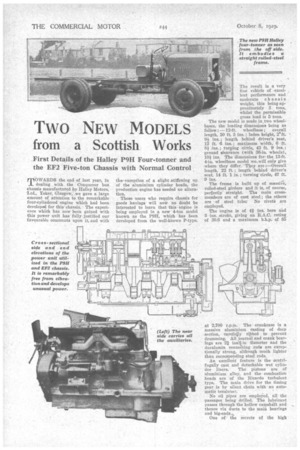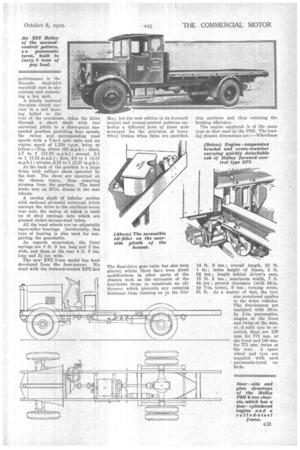TWO NEW MODELS from a Scottish Works
Page 60

Page 61

If you've noticed an error in this article please click here to report it so we can fix it.
First Details of the Halley P9H Four-tonner and the EF2 Five-ton Chassis with Normal Control
TOWARDS the end of last year, in dealing with the Conqueror bus chassis manufactured by Halley Motors, Ltd., Yoker, Glasgow, we gave a large amount of attention to the remarkable four-cylindered engine which had been developed for this chassis. The experience which has now been gained with this power unit has fully •justified our favourable comments upon it, and with
• •
theexception of a slight •stiffening lip of the aluminium cylinder heads, the production engine has needed no alteration.
Those users who require chassis for goods haulage will noir no doubt be interested to learn that this engine is being employed in a new 4-ton model known as the 139H, which has been developed from the well-known E-type.
The result is a very line vehicle of .excellent performance and moderate chassis weight, this being proximately 3 tons, whilst the permissible gross load is 5 tons.
The new model is made in two wheelbases, the leading dimensions being as
follow:— 12-ft. wheelbase ; overall length, 20 ft. 5 ins.; laden height, 2‘ft. 0-i ins.; length behind driver's seat, 12 ft. 6 ins.; maximum width, 6 ft. Si ins.; turning circle, 43 ft. 9 ins.; ground clearance (with 36-in. wheels), 101 ins. The dimensions for the.13-ft. 4-in, wheelbase model we,will only give .where they differ.. 'Tljey are :—Overall length, 22 ft.; length behind driver's seat, 14 ft. 1 in.; turning circle, 47 ft. 9 ins.
The frame is built up of massive, rolled-steel girders and it is, of course, perfectly straight. The main crossmembers are of cast steel; the others. are of steel tube: No rivets are employed.
The engine is of 4a ins, bore and 5 ins. stroke, giving an R.A.C. rating of 30.6 and a maximum b.b.p. of 85
at 2,700 r.p.m. The crankcase is a massive aluminium casting of deep section, Carefully ribbed to prevent drumming. All journal and crank bearings are 21 inslin diameter and the duralutoin connecting, rods are exceptionally strong, although muCh lighter than corresponding steel rods.
An excellent feature is the centrifugally cast and detachable wet cylinder liners. The pistons are of aluminium alloy, and the combustion heads are of the Ricardo turbulent type. The main drive for the timing gear is by silent chain with an auto matic tensioner. '
No oil pipes are employed, all the passages being drilled. The lubricant passes through the hollow earashtift and thence via duets to the main bearings and big-ends.z,
One of' the secrets of the high performance is the Ricardo dual-inlet manifold cast in aluminium and embodying a hot spot.
A totally enclosed dry-plate clutchcar ried in a bell housing bolted to the rear of the crankcase, takes the drive_ through a short shaft with two universal joints to a three-point suspended gearbox providing four speeds, the ratios and corresponding road speeds with a 7-to-1 axle ratio and an engine speed of 1,250 r.p.m. being as follow :—Top, direct (20 m.b.h.) ; third, 1.7 to 1 (11.75 m.p.h.) ; second, 2.8 to 1 (7.15 m.p.h.) ; first, 4.8 to 1 (4.17 m.p.h.) ; reverse, 6.15 to 1 (2.27 m.p.h.).
At the back of the gearbox is a large drum with calliper shoes operated by the foot. The shoes are mounted on the chassis frame, thus removing stresses from the gearbox: The hand brake acts on 20-in, drums in the rear wheels.
A card= shaft of tubular section with enclosed all-metal universal joints conveys the drive to the overhead-worm rear axle, the casing of which is built up of steel castings into which are pressed nickel-chrome-steel tubes.
All the road wheels run on adjustable taper-roller bearings. Incidentally, this type of bearing is also used for supporting the gearshafts.
As regards suspension, the front springs are 3 ft. 9 ins, long and 3 ins. wide, and those at the rear 4 ft. 6 ins. long and 3i ins. wide.
The new EF2 5-ton model has been developed from the four-tonner. We dealt with the forward-control EF2 last May, but the new edition in it forwardcontrol and normal-control patterns embodies a different form of front axle arranged for the provision of frontwheel brakes when these are specified.
The final-drive gear ratio has also been altered, whilst there have been detail modifications in other parts of the chassis, such as the extension of the foot-brake drum to constitute an oilthrower which prevents any escaping lubricant from running on-to the fric
tion surfaces and thus reducing the braking efficiency.
The engine employed is of the same type as that used On the P9H. The leading chassis dimensions are :—Wheelbase 14 ft. 6 ins.; overall length, 23 ft. 1 in.; laden height of frame, 2 ft. 91 ins.; length behind driver's seat,
15 ft. 2 ins.; maximum width, 7 ft. 4i. ins. ; ground clearance (with 34-in. by 7-in. tyres), 9 ins.; turning circle, 51 ft. As a 'matter of fact, the tyre size mentioned applies to the 4-ton vehicles. The five-tonners are equipped with 36-in. by 8-in, pneumatics, singles at the front and twins at the rear, or, if solid tyes be required, these are 120 mm. for 771 mm. at the front and 140 mm. for 771 mm. twins at the• rear. A spare wheel and tyre are supplied with each pneumatic-tyred vehicle.




























































































































